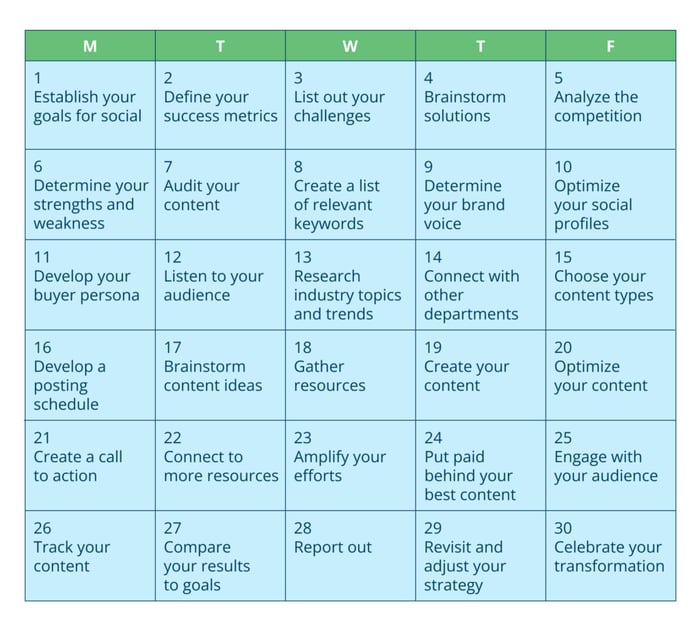Social media marketing can be daunting, but there’s one thing that successful brands have, and that’s a well-defined social media plan.
With so many platforms, post types, and tools to choose from, it’s important for businesses take social media planning seriously, and avoid posting to “just get something out there”.
In this guide, you’ll learn how to develop a complete social media plan that will set you on a path towards consistent growth.
A free social media plan template is included at the end of this guide: scroll down and grab your copy!

Manage all your social media accounts in one place.
Craft, schedule, & auto-post content to all your social channels, then track analytics and manage interactions from a single, easy-to-use dashboard.
What is a social media plan?
A social media plan is a comprehensive overview of everything you plan to do and hope to achieve on social media, including your:
- Business goals and objectives
- Social media content
- Approval workflows
- Performance measurement and analysis
It includes the following sections:
- Channel – Facebook, Twitter, Instagram, etc. Each platform has unique characteristics and audiences, so understanding which channels align with your goals is crucial.
- Purpose – Target audience and goals. This involves identifying your target audience and setting specific goals that you aim to achieve through your social media marketing campaigns. Having a clear purpose helps guide your content and messaging.
- Editorial – Featured topics, cadence, content formats, tone, brand voice, and resources. Allocating resources and establishing approval workflows within your team ensures a consistent and cohesive content strategy.
- Measurement – KPIs to measure content performance against goals. These KPIs could include metrics like engagement rate, reach, click-through rate, or conversions. Regularly analyzing these metrics helps you understand what works and what doesn’t, allowing for adjustments and optimizations to your strategy.
Why your brand needs a social media plan
A social media plan is essential to ensure the success of your overall social media marketing efforts. There are many benefits of using a social media content calendar. Here are a few of the reasons every brand needs to incorporate social media planning into their content strategy:

1) Ensures regular content production
A social media plan ensures that you’re able to produce content regularly, which is essential for maintaining a strong social media presence. By planning and scheduling content in advance, you’ve ensured a consistent flow of content without scrambling to develop ideas.
2) Improves branding
A well-executed social media plan enhances your brand’s image and reputation. Through consistent and strategic content creation, you can shape and reinforce your brand identity across social media platforms. Your plan should outline the visual elements, tone of voice, and key messages that align with your brand’s values and objectives. Maintaining a cohesive and recognizable brand presence establishes trust and credibility with your audience.
Additionally, social media provides an opportunity to showcase your brand’s personality and personally connect with your target audience.
3) Increases engagement
Social media planning enables you to create content that resonates with potential customers and encourages meaningful engagement. A well-planned social media strategy encourages likes, comments, shares, and mentions, whether through thought-provoking questions, polls, contests, or interactive features.
Increased engagement boosts your brand’s visibility and provides valuable insights into your audience’s preferences, opinions, and needs.
4) Helps drive (attributable) traffic to your website
A social media plan is a powerful tool for driving traffic to your website. By strategically sharing links to your website’s content, blog posts, product pages, or landing pages, you can attract qualified visitors and increase the likelihood of conversions. Your plan should outline the frequency and timing of these promotional posts to ensure maximum visibility and engagement.
Furthermore, social media platforms often offer advertising options that allow you to target specific demographics and interests, driving even more traffic to your website.
5) Enables you to measure results
A social media plan allows you to track and measure the outcomes of your social media efforts. By setting clear objectives and KPIs, you can evaluate the success of your campaigns and make data-driven decisions. Analyzing metrics like reach, engagement, website traffic, and conversions helps you understand what works and needs improvement. Measuring results also allows you to compare performance against competitors and industry benchmarks, showcasing the value of your social media activities.
How to create a social media plan in 7 simple steps
Now that you understand the importance of having a social media plan and what you should include in it, it’s time to dive in a little deeper and create one by following these seven simple steps:
- Set your goals and objectives
- Prepare your publishing schedule
- Fill your calendar with content ideas
- Create and customize content for each social network
- Review, approve, and schedule your content
- Engage with your audience
- Measure and adjust your plan

Step 1: Set your goals and objectives
The first step is to set your business goals, target market, brand identity, and editorial line.
1. Establish your business goals
Always set your business goals to measure your success and return on investment (ROI).
- Objectives define what and where you want to go.
- Goals define how and when you’ll get there.
Some examples of social media goals and objectives include:
- Lead generation
- Brand awareness
- Customer engagement
But these goals must help you achieve your overall business and marketing goals. For example:
- Business: increase customers
- Marketing: increase leads and conversions
- Social media: increase awareness
- Marketing: increase leads and conversions
Once you have decided on your goals, add some specific metrics so you can measure their success. For example, if you were using Instagram to increase followers and engagement, you might use:
- Followers – Increase the number of Instagram followers by 5% in Q1.
- Engagement – Increase the number of likes, comments, and shares on Instagram posts by 10% in Q1.
2. Define your target market
Next, you’ll want to define your target market. Knowing who your audience is and what they like determines what type of content to create.
Research your audience demographics and your competitors so that you know:
- Age ranges
- Gender breakdown
- Geographic location
- Competition in your market
Here are a few key considerations and steps to follow when defining your target market.
- Conduct market research: This provides you with a clear understanding of your ideal customers and how best to reach them on social media.
- Analyze existing customer data: Take advantage of your current customer data to gain deeper insights into your target market.
- Employ social listening tools: Social listening tools allow you to monitor conversations related to your industry, products, or brand on social media platforms.
- Create buyer personas: Once you’ve collected all the necessary data, use it to create detailed buyer personas.
3. Maintain your brand identity
Maintaining a consistent brand identity is crucial for a successful social media plan. Your brand identity encompasses the visual elements, messaging, and values that differentiate your brand from competitors. Here are key considerations for maintaining your brand identity on social media:
- Establish brand guidelines: Develop brand guidelines that outline the visual elements, such as logos, colors, typography, and imagery, that should be consistently used across all social media platforms.
- Define your brand voice: Are you formal, casual, humorous, or authoritative? Define the tone that resonates with your target audience and consistently use it in your social media content, captions, and responses.
- Consistent messaging: Every social media post should reflect your brand’s core message and communicate the value that your brand offers.
- Monitor brand mentions: Regularly monitor social media platforms for brand mentions, both positive and negative. Respond promptly and professionally to maintain a positive brand image.
One place you can maintain brand identity is in your social media profiles. You can create the same identity on each social platform. For example, look at how Nike uses the same handle, colors, and logos:
- Facebook:
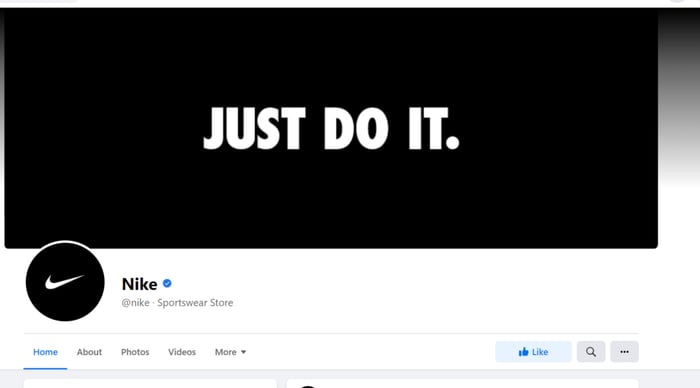
- Twitter:
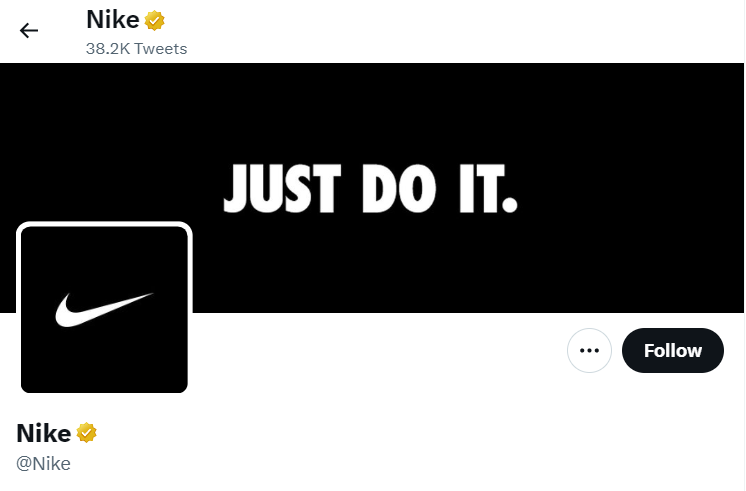
- Instagram:
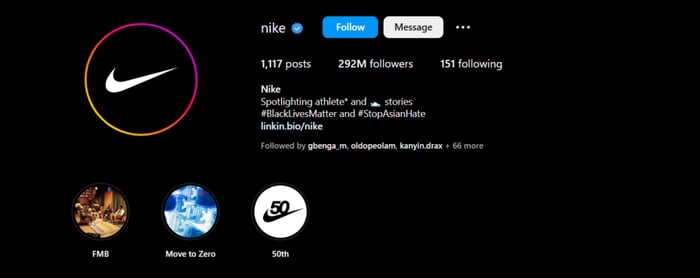
4. Craft your editorial line
You can craft your editorial line by answering a few simple questions:
- Personas: Who are you publishing for?
- Themes: What topics do you want to cover and avoid?
- Hashtags: Which hashtags do you want to use? e.g. branded, popular, etc.
- Angle: What style do you want to use? e.g. educational, informative, entertaining, etc.
- Voice: Who’s “speaking” in your posts?
- Tone: How do you want to address your audience? e.g. assertively, collaboratively, etc.
Step 2: Prepare your publishing schedule
The second step is all about planning your content ahead of time so that you can tell a consistent brand story. The last thing you want is to rush around at the last minute, desperately searching for something to post. That won’t work.
Planning your content also ensures you keep a regular schedule. It’s better to publish one high-quality post each day rather than going berserk with five posts one day, nothing for three days, followed by another couple of random posts. Your audience knows when to expect your next post when you publish regularly.
You can plan your content in a tool like Airtable, a spreadsheet template, or a professional, dedicated calendar like Loomly.
1. Determine your editorial cadence
Editorial calendars are typically set up on either a monthly or weekly cycle:
- Monthly calendars can help batch content work together to get a lot done faster.
- Weekly calendars can help you quickly pivot and adjust as you adapt to new trends more frequently.
Choose the cadence that best fits your team’s requirements. You can also read our in-depth article on building a social media calendar for more information about the topic.
2. Define your approval workflow
Your social media workflow should cover the process of reviewing and approving content before it’s published to make sure the right post gets published at the right time, in the right place, by the right person.
3. Choose your social channels
When deciding what social media channels to use, you need to consider which ones will help you achieve your business goals and which networks your target audience uses.
Hint: You don’t have to be on every channel!
A useful starting place for a side-by-side comparison of social media demographics is Pew Research data:
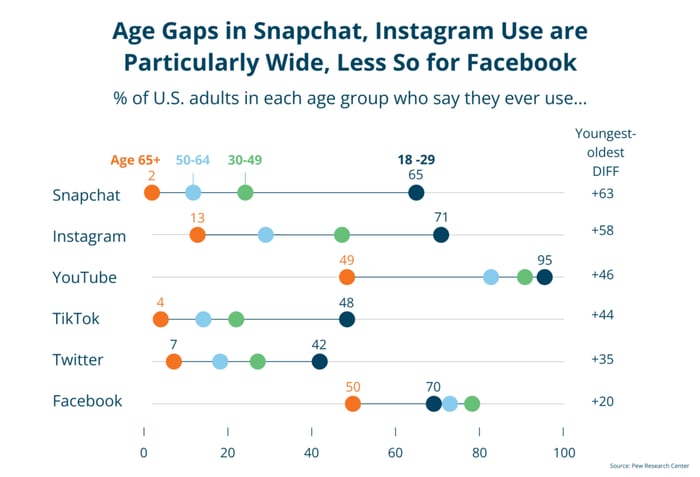
4. Decide your publishing frequency
Next, you’ll want to decide how often you’re going to publish content.
Here’s a brief overview of how many times you should post on different social media platforms
- Instagram: Post 3–5 times each week.
- Instagram Stories: Post 1-2 times daily.
- Twitter: Post 2–3 times daily.
- Facebook: Post 1–2 times daily.
- LinkedIn: Post 1-2 times daily.
- TikTok: Post 3–5 times each week.
Here are key tips to help you define your publishing frequency:
- Understand your audience’s social media habits and preferences
- Prioritize the quality of your social media content over quantity
- Experiment and analyze different publishing frequencies
- Remain consistent with your posting schedule
- Monitor audience engagement
- Evolve and adapt to industry trends and algorithm changes
In general, more posts are better to keep your audience engaged. But, as mentioned earlier, we highly recommend focusing on how many high-quality posts you can commit to posting every week or every month.
Step 3: Fill your calendar with content ideas
With your editorial cadence and publishing frequency defined, you can start filling your calendar with post ideas:
1. Enter important dates for your brand
Start by listing events that are important to your brand and your audience, such as:
- Product releases, sales promotions, and special events.
- Brand or company milestones such as anniversaries, achievements, and awards.
- Major holidays and events in your industry/niche.
2. Select the best publishing days per channel
After you’ve added fixed dates, you need to consider the best days to publish your other content.
Based on proprietary research, third-party studies, and, most importantly, your own experience, select the best publishing days per social media channel.
3. Fill in the gaps with evergreen ideas
Finally, fill in the remaining gaps with evergreen ideas. For example, you could:
- Feature user-generated content
- Curate relevant content
- Replicate previous high-performing posts
- Repurpose competitors’ content ideas
- Include social media trending topics
Loomly Tip: You can leverage Loomly’s built-in Post Ideas feature to fill your social media calendar. From Twitter Trends to RSS feeds, date-based events, and evergreen advice, you’ll never run out of inspiration.
Step 4: Create and customize content for each social network
The next step in your social media plan is allocating time and resources to create content. You’ll also need to allow time for customizing content for each of your chosen social networks.
1. Assign the publishing time
You’ve already decided on topics and dates for your content, but the final tweak is to select the best publishing time for each social network. You can base this on your previous publishing experience, proprietary research, and third-party studies.
For example, you might decide it’s best to publish on Facebook at 09:00 and on Twitter at 12:30 and 17:00.
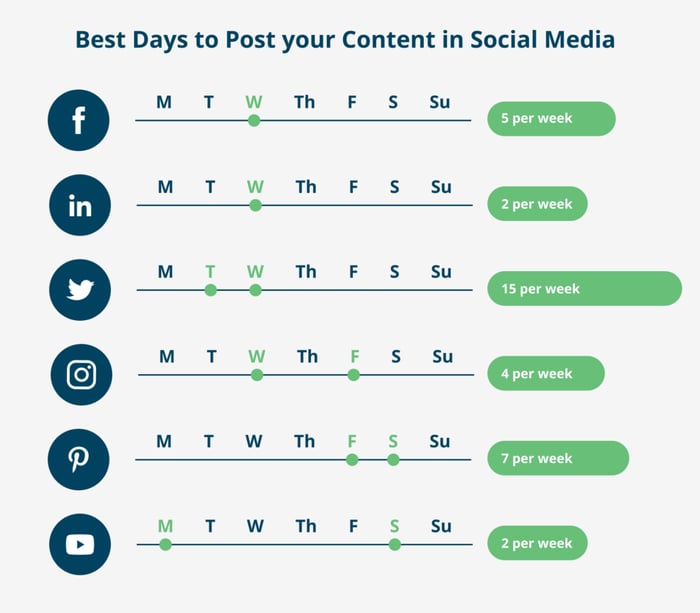
2. Craft your copy
When crafting the copy for your social media posts, you’ll need to consider a few core components, such as words, links, mentions, hashtags, and emojis.
You’ll also need to customize each post to fit each social network’s technical limitations, community best practices, and audience expectations.
For example, if you plan to post the same content on Facebook, Twitter, and LinkedIn, you could have a base version for Facebook, a short and snappy version for Twitter, and a longer, more formal version for LinkedIn.
Loomly Tip: When creating a post in Loomly for multiple social networks, you can define some generic content that’ll be applied by default to all channels and customize that generic content for each platform.
3. Create your visual assets
Alongside the copy, you’ll need to create your visual assets, such as:
- Photos: Static images and animated GIFs are great for conveying an instant message.
- Videos: Uploaded files, live presentations, and Stories share more information in an accessible format.
- A combination of the above: Slideshows, albums, and carousels encourage your audience to interact with your content.
All of these visual assets could be original material, user-generated content, or stock images. But either way, plan to store them in a central repository for your team to access now and in future posts.
Loomly Tip: You can store, organize, and use photos, videos, notes, links, and post templates in Loomly’s built-in Library Asset View.
Step 5: Review, approve, and schedule your content
Your social media plan is taking shape, but before any content gets published, you’ll want to ensure it’s been reviewed and approved.
The size of your organization will determine who needs to be involved in the review and approval process.
For instance, you might have a cross-functional team involving professionals from all departments in the company:
- Sales: to check the correctness of any sales messages.
- Product: to check the accuracy of product information.
- HR: to ensure the updates are in line with company policy.
- Finance: to ensure there are no budget issues.
- Legal: to ensure there are no liability issues.
- Third-Parties: any clients, agencies, or contractors you may be working with.
Whatever size team you use, make sure everyone knows what tasks they’re responsible for and allow ample time for reviewing, approving, and potential editing.
1. Review your posts
Reviewers need to have a clear preview of the post — including text and visuals — as it’ll appear on each social network, so they can confidently sign it off.
Here are some key things to look out for during the review process:
- Brand consistency: Ensure the post reflects your brand’s visual identity, such as using the correct logo, colors, and fonts.
- Accuracy and factual correctness: Double-check any statistics, dates, names, or other details to avoid sharing misleading or incorrect information.
- Grammar and spelling: Use grammar and spell-check tools to help catch any mistakes.
- Compliance with guidelines and policies: Ensure the content complies with platform-specific guidelines and policies.
- Call-to-action (CTA): Consider whether the post includes a clear and compelling call-to-action. A CTA prompts your audience to take a specific action, such as visiting your website or purchasing.
Loomly Tip: Loomly automatically generates Posts Mockups for you and your team before you hit publish.
2. Approve your posts
Approvers need to check your posts for:
- Consistency with brand values (message).
- Compliance with brand guidelines (format).
- Alignment with brand strategy (goals).
- Any potential contextual risk (trending news).
- Typos and grammar errors (image).
Ideally, you want an approval system that allows you to keep track of team feedback, save post changes, and make collaborators accountable for their actions.
Loomly Tip: Loomly offers an end-to-end collaborative review workflow including approval statuses, commenting system, and version history.
3. Schedule your posts
Once your posts have been reviewed and approved, you can schedule them for the planned publishing date and time.

Scheduling your posts in advance ensures they get published at the correct time. Instead of constantly checking your calendar for notifications and prompts, you can focus on planning and creating quality content for your next cadence.
Loomly Tip: Loomly includes a built-in scheduler that allows you to automatically schedule your posts once they’re approved and saves you copying and pasting from spreadsheets.
Step 6: Engage with your audience
Having planned, prepared, and published your content, it can be easy to miss this next step.
But social media is all about dialog. No other marketing channel allows you to engage in direct conversation with your prospects and customers. So make sure you build time into your social media plan for interacting with your community.
- If you’re using social media for customer service, you’ll definitely want to focus on quick response times, so customers aren’t left hanging around.
- If one of your goals is to build a community, you’ll want to proactively like and share your member’s content.
The more open and transparent your interactions are, the more customers trust you.
Step 7: Measure the right metrics and adjust your plan
The final step is to measure the response of your audience to the content you publish.
Tracking performance metrics helps you identify what did and didn’t resonate with your audience so that you can fine-tune your content next time.
It also gives you a way to determine whether you’re achieving your business goals and objectives.
Some of the most important social media metrics include:
- Engagement: Likes, comments, shares, and clicks.
- Awareness: Impressions and reach.
- Share of voice: Volume and sentiment.
- Customer acquisition: Referrals and conversions.
- Customer care: Response rate and time.
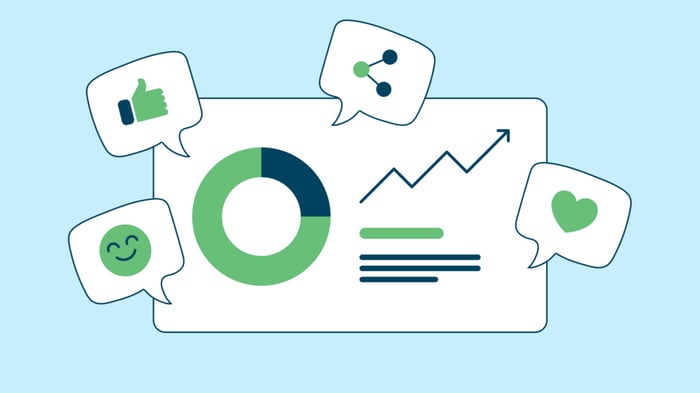
Whether you use each platform’s built-in analytics or a dedicated analytics tool, you should get pointers about:
- Where to post: Are there social networks where your content performs significantly better than others?
- When to post: Is there a pattern in terms of days of the week and times of the day when posts perform significantly better than others?
- What to post about: Are there topics, themes, and subjects that your audience visibly enjoys and engages with more than others?
- How to post: Does your audience tend to interact more with certain types of content, such as photos, videos, stories, or slideshows?
- Who to post for: Looking at your audience’s demographics, are you able to identify patterns between fans and followers who consistently engage with your posts?
Loomly Tip: Loomly’s Advanced Analytics features provide you with Account, Post, and Link metrics to measure your brand’s performance.
The bottom line:
Measure what content your audience likes (and dislikes) and leverage those insights when planning new content in your next publishing cycle. Your social media plan should be based on a cycle of continuous improvement where you plan, execute, measure, and fine-tune your content to achieve your goals.
Free social media plan template
It can come in a variety of shapes and forms:
- If you like to work locally on your desktop/laptop, here’s your free social media plan template in .xlsx format.
- If you like to work online, here’s your free social media plan template as an editable Google Doc file.
Start planning your social media with Loomly
Social media planning is essential to any successful social media marketing strategy. It helps businesses establish a clear roadmap for their social media activities, ensuring that you consistently produce high-quality content, engage with your audience, and track progress towards your marketing goals.
Investing in a well-crafted social media plan is vital whether you’re a small business owner or a marketing professional.
Loomly offers you the tools and templates to create a solid social media plan. Start your 15-day free trial today to increase brand awareness, drive traffic, and achieve your marketing goals.

